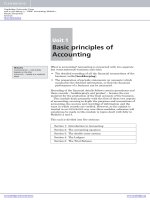acc101 principles of accounting group assignment
Bạn đang xem bản rút gọn của tài liệu. Xem và tải ngay bản đầy đủ của tài liệu tại đây (676.35 KB, 13 trang )
<span class="text_page_counter">Trang 1</span><div class="page_container" data-page="1">
<b>ACC101- PRINCIPLES OF ACCOUNTING GROUP ASSIGNMENT</b>
<b>GROUP 3:TRẦN PHI LONGNGUYỄN THỊ DIỆU LINHDƯƠNG DUY NHẬTNGUYỄN TRẦN TÂM NHƯTRẦN ĐINH GIA BẢOTRẦN ĐÌNH THÁIABBA ABDALLAH RILWAN</b>
<b>INSTRUCTOR: MISS. NGUYỄN MAI HOÀNG VY</b>
</div><span class="text_page_counter">Trang 2</span><div class="page_container" data-page="2">customers has grown. To accommodate the growth, the accounting system is modified to set up separateaccounts for each customer. The following chart of accounts includes the account number used for eachaccount and any balance as of December 31, 2019. Rick Connor decided to add a fourth digit with a decimalpoint to the 106 account number that had been used for the single Accounts Receivable account. This changeallows the company to continue using the existing chart of accounts.
<b>1. Journal entries</b>
4 Wages payable ($125×4)
</div><span class="text_page_counter">Trang 3</span><div class="page_container" data-page="3">17 Account payable 5,800Merchandise inventory
Cash ($5800−$58)
20 Sales return and allowances 500
Sales discount ($4,700×1%)
8,504
</div><span class="text_page_counter">Trang 5</span><div class="page_container" data-page="5"><b>AdjustmentsAdjusted Trial BalanceAccount</b>
</div><span class="text_page_counter">Trang 6</span><div class="page_container" data-page="6"><b>5551.110</b>
</div><span class="text_page_counter">Trang 7</span><div class="page_container" data-page="7"><b>676Mileage </b>
<b>677Miscellaneous Expense</b>
<b>Depreciation– Office Equipment</b>
<b>Depreciation– Computer Equipment</b>
<b>– Office Equipment</b>
<b>613Depreciation– Computer Equipment</b>
<b>414Sales returnsand allowances</b>
<b>discount</b>
</div><span class="text_page_counter">Trang 8</span><div class="page_container" data-page="8"><b>502Cost of goods </b>
<b>106.1Alex’sEngineering Co.</b>
For year ended
Revenue
</div><span class="text_page_counter">Trang 9</span><div class="page_container" data-page="9">For the three months ended March 31, 2022.
</div><span class="text_page_counter">Trang 10</span><div class="page_container" data-page="10">Add: Net income 18.833
<b>5. Classified balance sheet March 31, 2020.</b>
</div><span class="text_page_counter">Trang 11</span><div class="page_container" data-page="11">Less: Accumulated depreciation – computer equipment (2,500) (17,500)
</div><span class="text_page_counter">Trang 12</span><div class="page_container" data-page="12"><b>Gross Margin Ratio</b>
<b>Gross sale = Computer Services revenue + Sales = 25.307 + 19.240 = 44.457Net sales = Gross sales – Sales returns and allowances – Discount = 44.457 - 500 - 47= 43.910</b>
</div><span class="text_page_counter">Trang 13</span><div class="page_container" data-page="13"><b>Debt to assets RatioTotal Debt = 875</b>
<b>Total Assets = 120.268</b>
<b>Debt to assets Ratio = Total debt/ Total assets = 875/120.268 = 0.73</b>
<b>Profit margin</b>
Net income = 18.833Net sale = 43.910
Profit margin = Net income/ Net sales = 18.833/43.910 = 0.43
<b>Explain computation:</b>
The cost of goods sold makes up much of a merchandiser’s expenses. Without sufficient gross profit, a merchandiser will likely fail. Users often compute the gross margin ratio to help understand this relation. It differs from the profit margin ratio in that it excludes all costs except cost of goods sold. The gross margin ratio (also called gross profit ratio) is defined as gross margin (net sales minus cost of goods sold) divided by net sales
</div>








